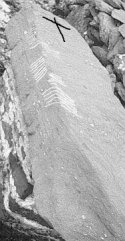Location and history:
According to Macalister, CIIC, the stone was erroneously named Leac Siobháine na nGimhlech (lac Sheevaun na geela in Ferguson, OI; Sean na Neelagh in Sheehy, Dingle), a name, which "properly applies to an isolated rock further out on the strand, derived from the name of a local lady who frequently used it as a mounting-block for getting upon her white steed (geal-each)".
There is an alternate name cloch Bruscuis which has no tradition with the local popoulation but was taken over from "Oghmists": this contains a "secondary" gen. Bruscuis to meet the attested (gen.) form Bruscos taken as a nominative (Macalister, Epig. 2, 60 and JRSAI 1897/98). According to Harbison, Guide, it is called "The Priest's Stone" ("Cloch an tSagairt" according to OSDP, 17).
Size according to Macalister, CIIC: 7'10" x 2'0" x 0'11".
- Published illustrations:
- Graves apud Ferguson, PRIA 15, 1871, 55 (
 woodcut);
woodcut);- Brash, OIM pl. XVI (
 draft of stone and cross);
draft of stone and cross);- Macalister, CIIC 173 (draft).
- Brash, OIM pl. XVI (
Reading Lhuyd (according to his sketch as quoted by Brash, OIM 173):
ᚏᚄᚉᚉᚑᚄᚊᚊᚓᚉᚐᚂᚏᚉ
S C C O S Q Q E CAL C
Reading Graves apud Ferguson, PRIA 15, 1871, 55:
BRUSCCOS MAQQI CALIACI
Reading Brash, OIM 171:
BRUSCCOSMAQQICALUOCOC
Reading Ferguson, OI 30 (41.):
BRUSCOSMAQICAL⌂I⌂ACI
"Bruscos Maqi Cal⌂i⌂aci" or Caluoci.
Reading Macalister, Epig. 1, 59 (35.: "Emalaugh East"):
BRUSCCOS MAQQICALIACI
Reading Macalister, CIIC:
BRUSCCOS MAQQI CALIACI[AS] M[AQQI MUCOI ...
Reading O'Kelly, JCHAS 50, 1945, 152:
Reading Harbison, Guide 113:
BRUSCCOS MAQQI CALIACI...M...
Interpretation Korolev, DP 81:
BRUSCCOS MAQQI CALIACI
Reading Sheehy, Dingle 16:
BRUSCCOS MAQQI CALIACIAS MAQQI MUCOI
Reading McManus, Guide 66:
BRUSCCOS MAQQI CALiACi
Reading OSDP, 17:
BRUSCCOS MAQQI CALIACI
Reading Gippert (1978):
 Dexter angle - "up":
Dexter angle - "up":BRUSCCOS MAQQI CAL(IA)C[I
ᚁᚏᚒᚄᚉᚉᚑᚄᚋᚐᚊᚊᚔᚉᚐᚂ(ᚔᚐ)ᚉ[ᚔ
ᚁᚋᚋᚋᚋᚋᚐᚐᚐᚁᚁᚁᚁᚆᚆᚆᚆᚆᚆᚆᚆᚐᚐᚁᚁᚁᚁᚋᚐᚆᚆᚆᚆᚆᚆᚆᚆᚆᚆᚆᚐᚐᚐᚐᚆᚆᚆᚆᚐᚁᚁᚐ(ᚐᚐᚐᚐᚐ)ᚆᚆᚆᚆ[ᚐᚐᚐᚐᚐ
- Windele, Notices of Cork and its Vicinity .., 400 (according to Brash, OIM 174).
- Lady Chatterton, Rambles in the South of Ireland, I, 205.
- O'Connor, Rerum Hibernicarum Scriptoris Vet., I, XXXIII
- Hall, Ireland, I, 205 "
- JRSAI 1897-1898 (Macalister? cf. Epig.
- Lady Chatterton, Rambles in the South of Ireland, I, 205.